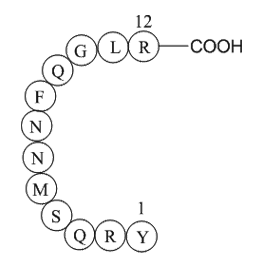Adrenomedullin (1-12), human (Synonyms: H2N-Tyr-Arg-Gln-Ser-Met-Asn-Asn-Phe-Gln-Gly-Leu-Arg-OH ) |
| Catalog No.GP10113 |
An N-terminal fragment of adrenomedullin
Products are for research use only. Not for human use. We do not sell to patients.

Sample solution is provided at 25 µL, 10mM.
Adrenomedullin (AM) (1-12), human (C64H100N22O19S1), is a peptide with the sequence Tyr-Arg-Gln-Ser-Met-Asn-Asn-Phe-Gln-Gly-Leu-Arg. It was first discovered to be associated with pheochromocytoma, a tumor arising from adrenal medulla, in 1993. AM was initially identified as a vasodilator, and as such, it has the ability to relax vascular tone. Previous research cited it as the most potent endogenous vasodilatory peptide found in the body. Other effects of AM include the increase of cell tolerance to oxidative stress and hypoxic injury and angiogenesis. AM is seen as a positive influence in diseases such as hypertension, myocardial infarction, chronic obstructive pulmonary disease and other cardiovascular conditions.
Average Rating: 5 (Based on Reviews and 30 reference(s) in Google Scholar.)
GLPBIO products are for RESEARCH USE ONLY. Please make sure your review or question is research based.
Required fields are marked with *




















